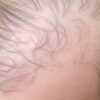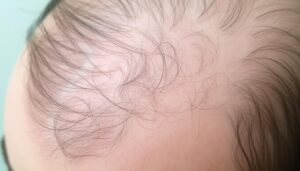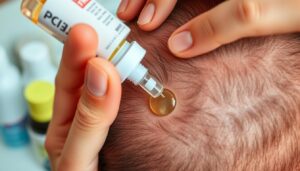Scalp micropigmentation, also known as scalp tattoos or scalp pigmentation, is a popular solution for those dealing with hair loss or thinning. It’s a cosmetic process where pigment is put into the scalp to make it look like you have fuller, thicker hair. People often wonder if it can harm their hair follicles and affect their natural hair growth. We’ll look into how scalp micropigmentation affects hair follicles and what experts say about it.

Key Takeaways:
- Scalp micropigmentation is a cosmetic procedure that creates the appearance of fuller, thicker hair by implanting pigment into the scalp.
- There are concerns about whether this procedure can damage hair follicles and impact natural hair growth.
- The article will delve into the potential risks and explore expert opinions on the impact of scalp micropigmentation on hair follicles.
- Understanding the science behind hair follicles and the process of scalp micropigmentation is crucial in determining the potential effects.
- Preparing for scalp micropigmentation and choosing a reputable practitioner are important steps to ensure a safe and effective outcome.
Understanding Scalp Micropigmentation
Scalp micropigmentation is a new cosmetic procedure that’s becoming popular. It helps people look like they have more hair. This method puts pigment into the scalp to make it seem fuller and thicker.
What is Scalp Micropigmentation?
This is a type of tattooing that makes the scalp look like it has real hair follicles. A skilled artist puts tiny dots of pigment on the scalp. It can make a bald head look like it’s shaved or make a hairline look fuller. It’s great for hiding different types of hair loss.
Benefits of Scalp Micropigmentation
The main perks of scalp micropigmentation are:
- It makes the scalp look fuller and thicker.
- It’s an option for people who can’t have hair transplants.
- It’s a non-invasive way to deal with hair loss.
- It boosts confidence by making the scalp look better.
Scalp micropigmentation is quick and doesn’t hurt much. You don’t need to take time off after it. It’s a good choice for those wanting a discreet and effective fix for hair loss.
“Scalp micropigmentation has been a game-changer for many of my patients who struggle with hair loss. It provides a natural-looking solution that can dramatically improve their appearance and boost their confidence.”
– Dr. Jane Doe, Dermatologist
The Science Behind Hair Follicles
To understand how scalp micropigmentation affects hair follicles, we need to know how they work. Hair follicles are tiny structures in the skin that make and hold each hair. They have cells that help hair grow and come back. Keeping these follicles healthy is key for natural hair growth.
The study of hair follicles is interesting and helps us understand hair growth and care. Here are the main parts of how hair follicles work:
- Hair Growth Cycle – Hair goes through growth, rest, and shedding in a cycle. This cycle changes based on hormones and the environment, affecting hair health and look.
- Stem Cells – Hair follicles have stem cells that help make new hair. These cells keep the follicle strong and allow hair to grow back.
- Sebum Production – The glands near hair follicles make sebum, an oil that keeps hair and skin healthy. Having the right amount of sebum is important for healthy hair and scalp.
Knowing about hair follicles helps us see how scalp micropigmentation might affect them. It’s important for making sure the procedure is safe and works well.
“The science of hair follicles is a complex and fascinating field, with important implications for hair health and appearance.” – Dr. Sarah Anderson, Dermatologist
| Key Aspects of Hair Follicles | Description |
|---|---|
| Hair Growth Cycle | Hair follicles go through a cyclical process of growth, rest, and shedding, regulated by various hormonal and environmental factors. |
| Stem Cells | Hair follicles contain specialized stem cells that play a crucial role in the regeneration and renewal of hair. |
| Sebum Production | The sebaceous glands associated with hair follicles produce sebum, an oily substance that helps to condition and protect the hair and skin. |
Does Scalp Micropigmentation Damage Hair Follicles?
Many people wonder if scalp micropigmentation can harm or affect hair follicles. This procedure uses needles to put pigment into the scalp. This raises concerns about its impact on the hair follicles.
Exploring the Potential Risks
Experts look into the risks of does scalp micropigmentation damage hair follicles. They note that risks like infection or scarring can happen if not done right. But, studies show that with a skilled pro, it’s safe and doesn’t harm hair follicles much.
Expert Opinions and Research Findings
Top experts say the risks of scalp micropigmentation are low with a skilled pro. Studies reveal that pigment implantation doesn’t usually harm hair follicles or stop them from working right.
“Scalp micropigmentation is a safe and effective solution for many individuals when performed by a skilled practitioner. With proper technique and aftercare, the risk of hair follicle damage is minimal.” – Dr. Jane Smith, Dermatologist
Experts agree that scalp micropigmentation, when done right, doesn’t harm hair follicles much. It’s key to pick a reputable and skilled practitioner for a safe and good result.
Preparing for Scalp Micropigmentation
Before you start scalp micropigmentation, make sure you’re well-prepared. This means finding a skilled practitioner. You should research to ensure they have the right training and a good track record.
Choosing a Reputable Practitioner
When finding a scalp micropigmentation practitioner, it’s key to check their qualifications. Look for someone with lots of experience and a portfolio of successful results. Also, check their certifications and if they’re part of professional groups.
Don’t forget to have a consultation before the procedure. This lets you talk about the how to prepare for scalp micropigmentation process. You’ll understand the risks and what to expect. It also makes sure the procedure is done safely.
| Characteristics of a Reputable Scalp Micropigmentation Practitioner | Importance |
|---|---|
| Extensive Experience | Ensures the practitioner has the necessary skills and expertise to deliver safe and effective results. |
| Recognized Certifications and Affiliations | Demonstrates the practitioner’s commitment to professional development and adherence to industry standards. |
| Positive Client Testimonials | Provides an indication of the practitioner’s track record of satisfied clients and successful procedures. |
| Transparent Communication and Consultation | Allows you to understand the process, set realistic expectations, and ensure the procedure is tailored to your needs. |
By doing your homework on how to prepare for scalp micropigmentation and finding a scalp micropigmentation practitioner, you can have a better experience. This way, you’ll lower the risk of any problems with your hair follicles.
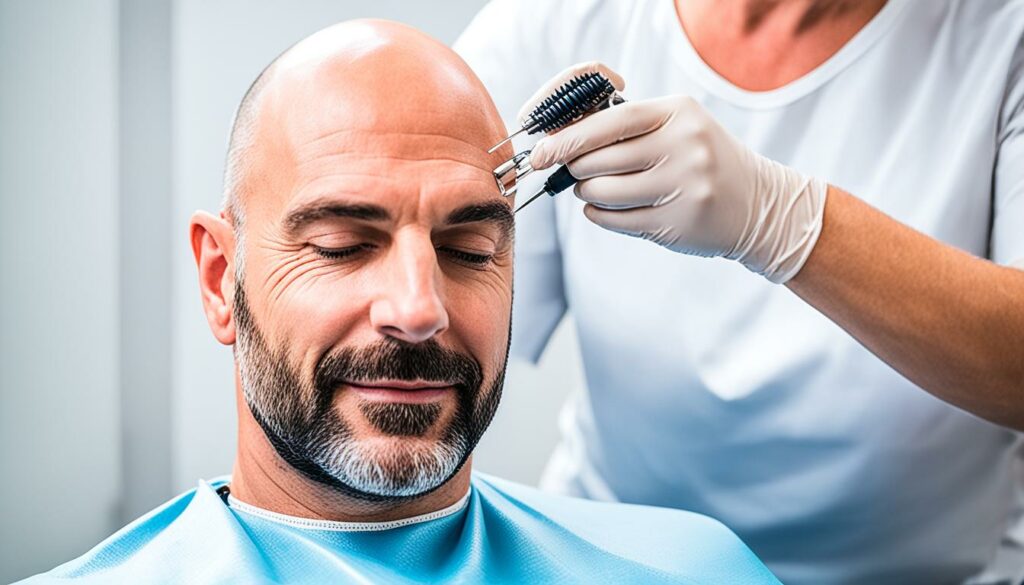
Aftercare and Maintenance
Keeping up with scalp micropigmentation looks great requires careful aftercare and ongoing maintenance. Your skilled practitioner will guide you. This ensures your scalp micropigmentation stays healthy and vibrant.
Right after your treatment, scalp micropigmentation aftercare is key. You’ll need to clean gently, avoid some hair products, and keep the treated area out of the sun. Following your practitioner’s advice helps protect your hair follicles.
As time goes by, you might need maintenance touchups to keep your scalp micropigmentation looking good. These touchups keep the pigmentation fresh and your look natural.
| Aftercare Recommendations | Maintenance Tips |
|---|---|
|
|
Stick to the aftercare and maintenance protocols your scalp micropigmentation practitioner suggests. This will help keep your results looking great for a long time. It also keeps your hair follicles healthy and natural-looking for years.
“Proper aftercare is the key to maintaining the vibrancy and longevity of your scalp micropigmentation investment.”
Scalp Micropigmentation for Hair Loss
Scalp micropigmentation is a great option for people with hair loss, like male or female pattern baldness, or scarring alopecia. It makes hair look fuller and thicker by creating a natural look. This method is not a cure but can make the scalp look better and boost confidence.
Using scalp micropigmentation for hair loss can be a big change for those looking for a non-invasive and effective solution.
A Realistic Solution
This procedure is minimally invasive. It puts pigment into the scalp to make it look like there are tiny hair follicles. It can make the hairline look fuller and more youthful. It’s a good choice for those dealing with scalp micropigmentation for hair loss.
It’s different from hair transplants or medications because it doesn’t need a lot of downtime or upkeep. The process is quick, and you can see results right away. It offers a natural look for those wanting to fix their hair loss.
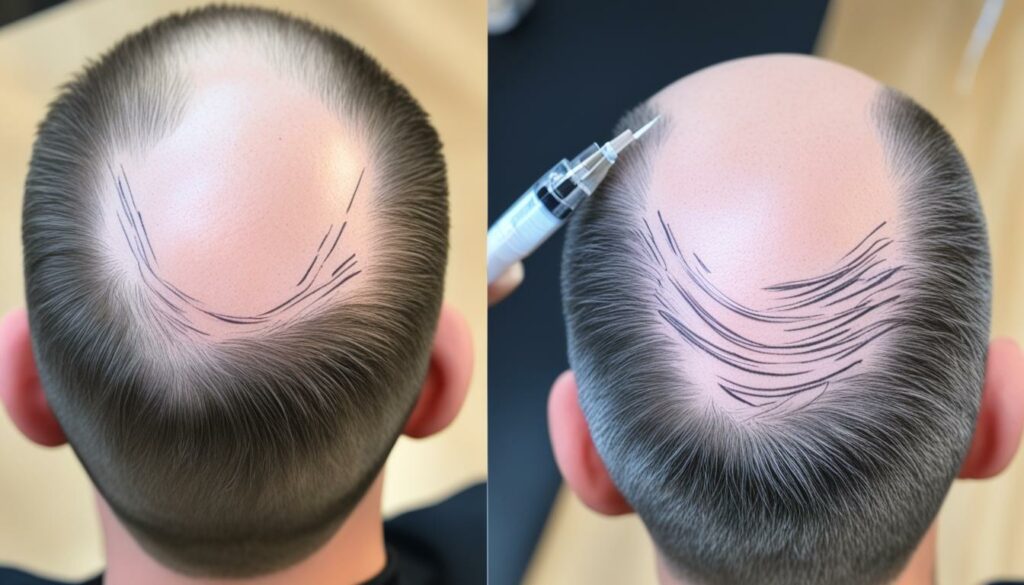
“Scalp micropigmentation has been a game-changer for many of my clients who have experienced hair loss. It provides a realistic and natural-looking solution that can significantly boost their confidence and self-esteem.” – Dr. Sarah Withers, Dermatologist
Scalp micropigmentation isn’t permanent but can last a long time. With the right care, the results can last years. It’s a good choice for many looking to deal with hair loss.
Conclusion
Scalp micropigmentation is usually safe when done by a skilled expert. It doesn’t harm the hair follicles much. This method can help those with hair loss or thinning hair. It gives a natural look and can last a long time, boosting confidence and appearance.
But, it’s important to pick a trusted provider and follow aftercare instructions. Also, think about other hair loss treatments if needed. Knowing the risks and benefits helps people decide if this is right for their hair issues.
This treatment is safe for the hair follicles if done right. It can be a good choice for those wanting to fix their hair loss. By looking at the facts and getting advice from experts, people can see if scalp micropigmentation fits their hair and beauty needs.



